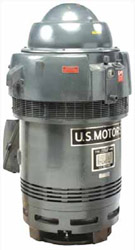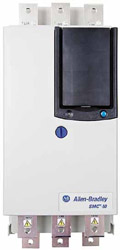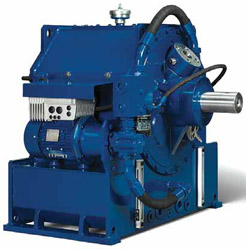 New-generation motor lines, such as the Siemens HV unit shown
New-generation motor lines, such as the Siemens HV unit shown
here, offer a variety of configurations and features.
For example,
HV M models can be specified with cooling setups such as
air-air and air-water heat exchangers,
open-circuit, through
ventilation, rib cooling, pipe cooling and water-jacket cooling.
They can provide fixed- and
variable-speed operation and motor
solutions for drive systems with and without gearboxes.
The dictionary defines the word ubiquitous
as “being everywhere; constantly encountered,”
and in the mining industry, nothing
comes closer to that definition than
electric motors and their associated drives
and couplings. Powering everything from
SAG mills to samplers, motors literally
keep mine sites humming on a more-orless
continuous basis.
Challenged by the needs and expectations
of mining customers, motor-technology
purveyors are highly motivated
to find ways to move the needle farther
toward the “more” end of the dial, and
not just in terms of performance — demand,
too, is steadily increasing. In fact,
the market for motors has expanded at a
healthy 7.4% clip since 2009, according
to IMARC Group, with the global market
valued at $93.2 billion in 2017. Industrial-
sector sales account for 60% of that
market, and those figures don’t include
the electronic-drive controllers and power
transmission equipment such as couplers
and gearboxes that typically are part of
many medium- to high-horsepower mine
motor installations.
A recent equipment order for an underground
mine project in Mongolia illustrates
the expanding scope of motor-related
equipment orders that are becoming
more common throughout the industry.
Siemens announced it will supply engineering,
design, production, and supply
of electrical equipment for underground
and surface conveyor systems at the Rio
Tinto-managed Oyu Tolgoi copper mine.
The conveyors will be powered by gearless
and conventional drives from thyssenkrupp
Industrial Solutions, and are
expected to bring 95,000 metric tons per
day (mt/d) of copper ore to the surface,
traveling a route that includes a difference
in height of almost 1,400 m. The
order value, according to Siemens, is in
the “tens of millions of Euros.”
The transport system consists of a total
of nine conveyors — seven underground
and two at surface. Four of these conveyor
belts have a gearless design, each with
two 5.5-megawatt drive systems. Siemens
is supplying thyssenkrupp with 8DA10
(gas-insulated) and NX-AIR (air-insulated)
medium-voltage switchgear, transformers,
low-voltage energy distribution, Sinamics
SL 150 and Sinamics S150 frequency
converters as well as low-speed synchronous
motors with a nominal power of 5.5
megawatts and smaller squirrel cage induction
motors. The delivery also includes
pre-assembled E-Houses for installing the
equipment as well as power factor correction
and harmonic filtering equipment.
Higher Equipment IQ
In tune with the needs of an industry
increasingly interested in exploiting IoT
opportunities, data analysis schemes
and higher levels of machine automation,
along with energy conservation and
reduced maintenance/operations costs,
recent product improvements have been
mainly focused on making electric motors
and their accessories smarter, stronger
and more versatile.
Major motor suppliers, such as Baldor
(recently rebranded as ABB), Nidec, Regal
Beloit, Teco-Westinghouse, Toshiba and
others, offer a variety of standard mine-duty
motor models that typically include
high-, medium- and low-voltage versions,
robust frames, extreme temperature performance
capabilities, high IP ratings and
enhanced lubrication features. Several manufacturers also have introduced new
motor configurations aimed at meeting
specific mine-application demands.
 Nidec’s TEFC inverter duty motors
Nidec’s TEFC inverter duty motors
are designed specifically
to meet
the needs of vertical turbine shaft
applications.
One example of this trend comes from
Nidec, which pointed out that the use of
inverters in mine pumping applications
has increased dramatically over the past
few years. The combination of an inverter
and induction motor with a pump produces
an economical variable-speed drive
system that has the potential to provide
energy savings and process optimization,
according to the company. It may also
lead to improved system reliability.
Responding to rising demand for variable
speed motors in industrial applications,
in October 2017, Nidec added
U.S. Motors brand vertical totally enclosed
fan cooled (TEFC) inverter duty
motors to its stocked offerings. These vertical
HOLLOSHAFT high-thrust motors,
for use on turbine, mix flow and propeller
pumps, range from 5 hp to 300 hp, and
are suitable for variable frequency drive
(VFD) operation per NEMA standards.
The HOLLOSHAFT motor was developed
to meet the specific needs of the
vertical turbine pump industry. The pump
shaft is extended through the hollow
shaft, so adjustments required to lift impellers
and give a running clearance with
the pump casing, can be made by a nut
threaded on the shaft at the accessible
top portion of the motor.
On a broader scale, innovations in
sensor, communication and analytical
technologies, combined with their subsequent
cost reductions, are leading to
an increased demand for remote wireless
condition monitoring solutions in a
wide array of industries. These include
metals and mining, according to Thomas
Schardt, Nidec’s senior director of IoT.
“End users expect access to real-time
data at a much lower cost compared to
traditional route-based monitoring. We
recognize an increasing demand in the
manufacturing industry to monitor and
assess machine health condition in order
to avoid unexpected downtimes and
loss of production time,” said Schardt.
“There is a global trend for companies
to use IoT to gather real-time data and
achieve quantifiable results that deliver
better performance and cost savings. Our
solution is based on simplicity, reliability,
connectivity and diagnostic intelligence.”
Nidec’s solution is FORECYTE, a
stand-alone remote monitoring platform
introduced last year that uses battery-
powered wireless sensors to measure
equipment vibration and temperature.
FORECYTE collects continuous, real-time
data, and visualizes deteriorating equipment
health. The data is sent wirelessly
from the sensor to a gateway and from
there through either Ethernet, Wi-Fi or
cellular to a cloud portal where it is aggregated,
stored, analyzed and visualized
using a web interface. Data can be accessed
at anytime from anywhere using a
browser on a web-enabled device.
According to Nidec, this advanced
form of monitoring offers more value
when predictive analytics are added to
the equation. Using algorithms, the data
collected through monitoring can be modeled
to identify patterns that help users
not only intervene on imminent breakdowns,
but predict future behaviors and
events. Additional sensors and analytics
currently being developed, said Nidec,
will empower end-users to make smarter,
performance-based equipment decisions,
ultimately leading to lower operating
costs and longer equipment service
life. The platform is scalable and has the
capability to be integrated with existing
supervisory control and data acquisition
(SCADA) and legacy systems.
Motors Save Megawatts
In regions such as Africa, where electrical
power can be unreliable, of poor quality
and/or prohibitively expensive, modern
high-efficiency motors can help cut energy
bills and maintenance. Zest WEG, an
Africa-based subsidiary of Brazilian electrical
equipment manufacturer WEG, is
taking aim at that market.
Almost two-thirds of the power consumed
by the mining sector is associated
with electric motors, so these items
of equipment are important for mines
to look at when demanding savings,
according to Zest WEG Group’s African
business development executive, Edson
Cristofolini.
“Where an old 55-kW motor is operating
24 hours a day and seven days a
week, we estimate that a mine can save
over 20 MW a year by replacing it with
a new WEG Top Premium Efficiency IE3
motor,” said Cristofolini.
These savings add up when considering
how many motors are operational
on a large mine, he pointed out, also
noting that apart from reducing energy
consumption, the WEG motors also
contribute to mine profitability through
a combination of long life, low maintenance
and reliability.
“Repairs and replacements are especially
costly and time consuming for
mines in remote locations, so these motors
are designed to operate reliably under
harsh operating conditions,” he said.
“An important aspect of the design in the
WEG Top Premium Efficiency IE3 range,
for instance, is the class H Insulation
with class B temperature rise.”
This provides a buffer of 60°C
between the motor windings’ average
operating temperature and the actual
motor insulation capability, protecting
the motor where quality of power varies
or where ambient temperatures are
very high.
The motors’ design also provides a service
factor of 1.15, allowing a motor to
be overloaded by up to 15% continuously
without compromising reliability, according
to WEG. With the lower losses and the
reduced operating temperature of these
high efficiency motors, bearing temperatures
are also lower.
“Lower bearing temperature means
that less grease is used, and the intervals
between the re-greasing of bearings are
longer,” said Cristofolini.
Dust and water ingress is prevented
by WEG’s W3 seal arrangement, which
comes with an IP66 rating. This is the
highest level of protection before entering
the category of submersible motors.
“Taking into account that many mine
sites often do not have extensive workshop
facilities, the motors are designed
for easy installation and maintenance,
with solid feet and increased terminal
box sizes that allow easy connections,”
Cristofolini said, adding that it is worthwhile
for mines to prioritize the total
cost of ownership with high-quality design
and efficient performance in their
choice of motors, with reduced maintenance
and operational costs, as the
capital cost makes up only about 2%
of the motor’s cost of operation over a
10-year life.
 Allen-Bradley’s new SMC-50
Allen-Bradley’s new SMC-50
motor controller offers a
wide
variety of device communications
options, including
EitherNet/IP
and DeviceNet networks.
Start, Stop, Report
Although motors are made to run for
prolonged periods, a closely controlled
startup and shutdown sequence are
also generally important elements of
a well-designed application. Targeting
that need, Rockwell Automation’s Allen-
Bradley subsidiary has introduced
the new SMC-50 smart motor controller
with internal bypass to provide greater
operational control over motor starts
and stops. Soft starters traditionally use
solid-state, silicon-controlled rectifiers
(SCRs) to control voltage to the motor
during startup, runtime and shutdowns.
The reduced torque and current slowly
introduces energy to the motor, mitigating
electrical and mechanical stress to
the application. If these SCRs remain in
the circuit once the motor is up to speed,
the heat generated by these devices
leads to electrical inefficiency.
“Users now have the option of choosing
the proper power structure for their
application when purchasing the SMC-
50 smart motor controller. For operations
that run over an extended period,
built-in internal bypass allows users to
shift from solid-state switches to bypass
contactors,” said Rick Anderson, product
manager for Soft Starters, Rockwell Automation.
“By switching over to the bypass
circuit, users can save on energy and
decrease operational costs by minimizing
excess heat buildup.”
The SMC-50 smart motor controller
with internal bypass provides access
to several communication modules, including
EtherNet/IP and DeviceNet networks.
This connectivity, combined with
its microprocessor platform, brings energy-
monitoring capabilities and protection
features that make applications easier to
troubleshoot and fix.
A New Spin on Motor Couplings
With electric motors being the almost
exclusive source of power for mine conveyor
belts, motor performance — and
the capability to tune performance to
the demands of a given conveyor system
— is a principal factor in conveyor efficiency and productivity. Consequently,
choosing the appropriate coupling
mechanism for transmitting motor power
to the conveyor is a crucial design
consideration.
Voith Turbo Inc., a specialist in drive
solutions, systems and comprehensive
services, recently introduced their Turbo-
Belt 500 TPXL hydrodynamic fluid coupling
as the first model in its TPXL family, which the company said is designed
specifically for conveyor applications and
combines the advantages of the hydrodynamic
drive principle with intelligent control
technology.
Voith has high expectations for industry
acceptance of the new coupling
family, which was developed to answer
the needs of its mining customers. Major
design features, explained Kyle Kluttz,
vice president, NBS Mining & Metals
Americas, who spoke with E&MJ’s Jesse
Morton at the 2018 SME annual meeting
and exposition in February, include
high-power density, a simplified but sophisticated
hydraulic system, lower capex
requirements, and suitability for both new
and retrofit applications.
 Voith Turbo introduced the 500-kW TurboBelt 500 TPXL
Voith Turbo introduced the 500-kW TurboBelt 500 TPXL
fluid coupling in 2017 and plans to follow up with 850-
and
1,250-kW units later this year.
“This coupling is a new spin on conventional
controlled-fill couplings. We’ve
redesigned the hydrodynamic circuit so
that the coupling enables almost double
the torque from the existing footprint,”
he said.
The 500-kW rated TurboBelt 500 TPXL
requires only half the volume of conventional
fluid coupling types with the same
force transmission, according to Kluttz,
while the integrated controller makes it
possible to adapt the output torque of the
coupling exactly to the startup parameters
of the conveyor system. The controller
monitors the coupling’s entire sensor array
and and provides vital operational information,
such as the condition of the oil
filter. That information can be accessed
remotely via the web, a capability which,
Kluttz noted, isn’t new to the industry, but
is a first for this type of drive.
The hydrodynamic circuit of the coupling
limits the torque in the driveline
to a fixed, defined value, which protects
the belt and the drive components from
damage due to overloading. This cuts
maintenance and repair costs and increases
the lifetime of the system. Motors
can be run up to speed under noload
conditions and staggered in time,
thus minimizing current peaks that occur
when motors are switched on, and also
reducing the load placed on the power
grid. The TurboBelt 500 TPXL’s built-in
Fieldbus unit, according to Voith, lays
the foundation for the device to play a
role in networked mining of the future.
“These features put us on the leading
edge of drive technology, and are consistent
with our aim to offer customers
the opportunity to develop ‘intelligent
mining,’” said Kluttz, who added that
the company sees opportunities for future
sales in both new project installations
as well as retrofit projects entailing
conveyor-system repowering, extension
or tonnage capacity increases. With the
introduction later this year of two higher-
powered TPXL models offering 850
and 1,250-kW capacities, respectively,
Voith expects industry interest to expand
to prospective customers planning or
currently running conventionally driven
high-powered conveyor systems. For
installation flexibility, Voith will offer
versions with bearings on both sides for
stand-alone use as well as a variant with
bearings on the output side for direct
motor connection.
As featured in Womp 2018 Vol 04 - www.womp-int.com



